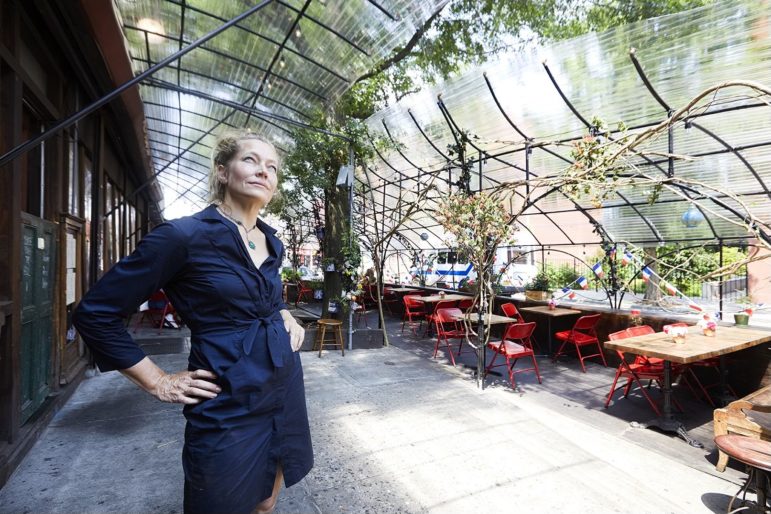‘Restaurants are a critical part of the economy, employing 10 percent of New Yorkers. We saw during the pandemic how important they are to communities. Outdoor spaces, heated and cooled, were gathering spaces through the year for weary New Yorkers.’

Shannon Greer
The author in Chez Oskar’s outdoor dining space.2020 was our worst year, but for every door that shuts a window opens, and as much as my colleagues and mine were shut abruptly, an unexpected window of opportunity opened.
On March 16, 2020, auxiliary police officers came by my restaurant, Chez Oskar, ordering us to close. Angelique Calmet-Strakker, Oskar’s general manager since 2012, Octavio Simancas, the chef since 1999, and I were devastated. Our bistro of 21 years was dying fast.
In April 2020, the streets became a ghost town. Ambulances, ice trucks, losing friends of friends, then friends. At Oskar, we stapled shop towels to rubber bands: one of many masks we would come to wear.
Given the circumstances, we were forced to work with third-party delivery apps, who seek to extract everything they can from the businesses they work with. A friend of mine called and asked: “Are you ok?” My response: a tirade of expletives. He again: “We need to get to work on a citywide outdoor dining program that includes restaurants like yours, that lost their commercial zoning years ago.” “GREAT!” I answered.
He knew that I had been trying for years with other restaurants in the neighborhood to get our establishments rezoned so that we could use our sidewalk for commercial purposes. Alone, it would cost us each about $100,000 and take two years with no certain outcome. I had been sending local officials a dotted map of restaurants without commercial overlay, vying for their support of outdoor dining for all of us, but hadn’t been making progress.
I had lost the commercial overlay in 2006. I wasn’t alone. Diminishing commercial corridors help big developers claim blight and get lower-interest loans and tax breaks to build big box businesses. It coincided with the quintupling of outdoor dining fees, making sidewalk cafes an exclusive club.
I circulated the dotted map again, this time broader. On May 15, Brooklyn Borough President Eric Adams wrote an open letter to Mayor Bill de Blasio supporting outdoor dining immediately for all restaurants, regardless of zoning issues. The window had cracked open.
 CityViews are readers’ opinions, not those of City Limits. Add your voice today!
CityViews are readers’ opinions, not those of City Limits. Add your voice today!
I pounded the pavement. About 30 of us “outcasts” came together throughout Bed-Stuy and Central Brooklyn, fighting to be included in the emergency outdoor dining program. We posted a video and testified to be added in. City Council approved. Applications were easy. For a city that usually is a tight ball of red tape, this was a miracle.
Our first outdoor dining set-up was socially distant tables and a thin bamboo separation. Soon we had to fortify structures, then we got tents, then corrugated clear, then radiant heat. The rules constantly changed. Every day a rollercoaster: fill out forms, fight the elements, fix violations. It was a long winter with makeshift carports, shutdowns, and re-openings.
In May of 2021, Angelique and I were yearning for a more aesthetic, welcoming, and permanent structure. We concocted a modern take on Art Nouveau in steel and clear. It made sense: Oskar is landmarked and French. To this day the structure (now covered in morning glory & wisteria) has survived three tropical systems. Our sidewalk is much more communal.
In total, 11,500 restaurants participated in the outdoor dining program, including 2,500 “grandfathered” restaurants like mine, which could never serve outdoors prior. Some though, after getting violations accompanied by the threat to revoke licenses, gave up on outdoor dining. You only get 24 hours to cure.
I am heartened about the proposed text amendment to remove the commercial zoning requirement for restaurants to serve outdoors. On Oct. 6, the City Planning Commission is holding a public hearing on this proposal, and I encourage all supporters and owners to take part and share positive feedback and a vision for the future.
Restaurants are a critical part of the economy, employing 10 percent of New Yorkers. We saw during the pandemic how important they are to communities. Outdoor spaces, heated and cooled, were gathering spaces through the year for weary New Yorkers.
The next challenge: creating encouraging rules to fight “ugly” and inequity, streamlining the program permanently and making it accessible to all, encouraging small business to make the investments that reflect outdoor dining as a community asset. This means more thoughtful design considering every use and user of the sidewalk.
To support smarter, more innovative rules and standards, that support beauty and enhance functionality, I have collected and shared recommendations with the Regional Plan Association and Department of City Planning, from allowing for year-round structures that accommodate all users of the sidewalk, for adjacent space for those with obstructions, a minimum of 10 seats per business, fair pricing, and more.
The restaurant industry was not adequately consulted on delivery app caps, reopening indoor dining dates, or the overnight cut off of “to-go liquor”—all of which were well-meant and half-assed. We restaurants have over a year’s worth of useful information. Don’t shut us out—hear us out!
Charlotta Janssen has been the owner of the restaurant Chez Oskar since 1998.








